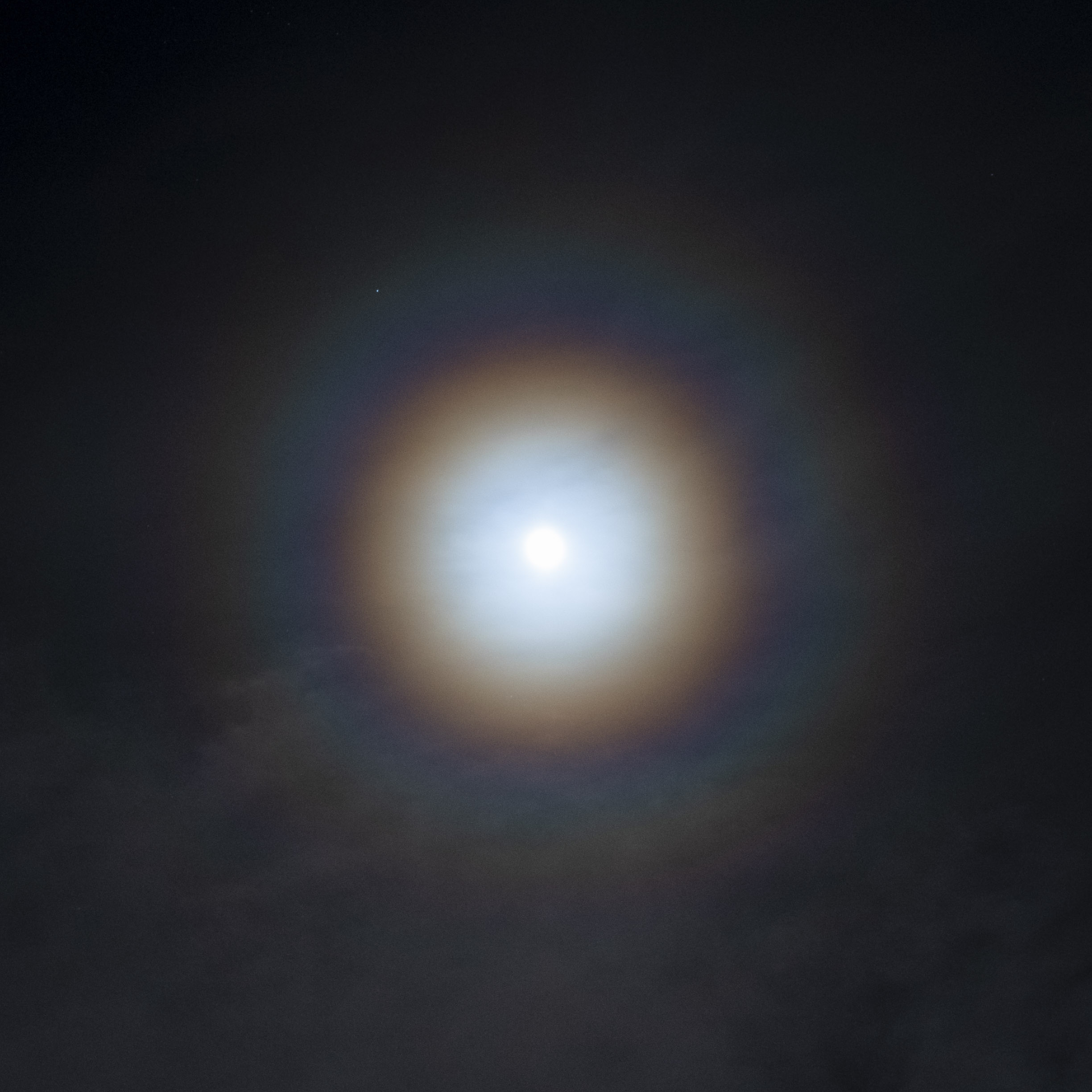Corona (meteorology) on:
[Wikipedia]
[Google]
[Amazon]

 In
In
Explanation and image gallery
- Atmospheric Optics by Les Cowley
Rings around the sun and moon: coronae and diffraction
Experimental simulations of pollen coronas
File:Coronae.jpg, Forest Corona
File:Coronae at GGB.jpg, Solar Corona at Golden Gate Bridge
File:Iridescent fog.jpg, Partial Corona at Golden Gate Bridge
File:Moon Marki 19032011 3.JPG, Lunar aureole
File:Janus24.jpg, Lunar corona with
Atmospheric optical phenomena
{{climate-stub

 In
In meteorology
Meteorology is a branch of the atmospheric sciences (which include atmospheric chemistry and physics) with a major focus on weather forecasting. The study of meteorology dates back millennia, though significant progress in meteorology did no ...
, a corona (plural ''coronae'') is an optical phenomenon
Optical phenomena are any observable events that result from the interaction of light and matter.
All optical phenomena coincide with quantum phenomena. Common optical phenomena are often due to the interaction of light from the sun or moon wit ...
produced by the diffraction of sunlight or moonlight (or, occasionally, bright starlight or planetlight) by individual small water droplets
A drop or droplet is a small column of liquid, bounded completely or almost completely by free surfaces. A drop may form when liquid accumulates at the lower end of a tube or other surface boundary, producing a hanging drop called a pendant d ...
and sometimes tiny ice crystals
Ice crystals are solid ice exhibiting atomic ordering on various length scales and include hexagonal columns, hexagonal plates, dendritic crystals, and diamond dust.
Formation
The hugely symmetric shapes are due to depositional growth, n ...
of a cloud
In meteorology, a cloud is an aerosol consisting of a visible mass of miniature liquid droplets, frozen crystals, or other particles suspended in the atmosphere of a planetary body or similar space. Water or various other chemicals may ...
or on a foggy glass surface. In its full form, a corona consists of several concentric, pastel-colored rings around the celestial object
An astronomical object, celestial object, stellar object or heavenly body is a naturally occurring physical entity, association, or structure that exists in the observable universe. In astronomy, the terms ''object'' and ''body'' are often u ...
and a central bright area called ''aureole''. The aureole is often (especially in case of the Moon
The Moon is Earth's only natural satellite. It is the fifth largest satellite in the Solar System and the largest and most massive relative to its parent planet, with a diameter about one-quarter that of Earth (comparable to the width of ...
) the only visible part of the corona and has the appearance of a bluish-white disk which fades to reddish-brown towards the edge. The angular diameter
The angular diameter, angular size, apparent diameter, or apparent size is an angular distance describing how large a sphere or circle appears from a given point of view. In the vision sciences, it is called the visual angle, and in optics, it is ...
of a corona depends on the sizes of the water droplets involved; smaller droplets produce larger coronae. For the same reason, the corona is the most pronounced when the size of the droplets is most uniform. Coronae differ from halo
Halo, halos or haloes usually refer to:
* Halo (optical phenomenon)
* Halo (religious iconography), a ring of light around the image of a head
HALO, halo, halos or haloes may also refer to:
Arts and entertainment Video games
* ''Halo'' (franch ...
s in that the latter are formed by refraction
In physics, refraction is the redirection of a wave as it passes from one medium to another. The redirection can be caused by the wave's change in speed or by a change in the medium. Refraction of light is the most commonly observed phenome ...
(rather than diffraction) from comparatively large rather than small ice crystals. The diffraction pattern is called an Airy disk
In optics, the Airy disk (or Airy disc) and Airy pattern are descriptions of the best- focused spot of light that a perfect lens with a circular aperture can make, limited by the diffraction of light. The Airy disk is of importance in physics, ...
.
Pollen coronae
Pollen suspended in the air can also cause diffraction of sunlight that produces coronae. Because pollen grains are not always spherical, the resulting pollen coronae often have characteristic elliptic shape and brighter spots in them. They can be seen during blooming season where there is significant source of pollen like forests. They are more easily seen during sunset or sunrise as there is less sun glare and the light path through pollen laden atmosphere is longer.See also
*Atmospheric diffraction
Atmospheric diffraction is manifested in the following principal ways:
* Optical atmospheric diffraction
* Radio wave diffraction is the scattering of radio frequency or lower frequencies from the Earth's ionosphere, resulting in the ability to ...
* Glory (optical phenomenon)
* 22° halo
References
External links
Explanation and image gallery
- Atmospheric Optics by Les Cowley
Rings around the sun and moon: coronae and diffraction
Experimental simulations of pollen coronas
Gallery
Altocumulus floccus
Altocumulus floccus is a cloud type named for its tuft-like, wooly appearance. The base of the cloud can form as low as , or as high as . They often form in clusters, or patches, and bases can vary in height with differing atmospheric conditions ...
File:Lunar corona.JPG, Lunar aureole as seen from Mumbai
Mumbai (, ; also known as Bombay — List of renamed Indian cities and states#Maharashtra, the official name until 1995) is the capital city of the Indian States and union territories of India, state of Maharashtra and the ''de facto'' fin ...
File:SolarDiffractionCorona.jpg, A solar corona soon after sunrise
Sunrise (or sunup) is the moment when the upper rim of the Sun appears on the horizon in the morning. The term can also refer to the entire process of the solar disk crossing the horizon and its accompanying atmospheric effects.
Terminology
A ...